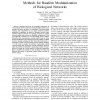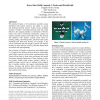114 search results - page 22 / 23 » Learning about natural human-robot interaction styles |
BIBE
2006
IEEE
14 years 3 days ago
2006
IEEE
— Biological networks are formalized summaries of our knowledge about interactions among biological system components, like genes, proteins, or metabolites. From their global top...
IUI
2010
ACM
14 years 2 months ago
2010
ACM
People interact with interfaces to accomplish goals, and knowledge about human goals can be useful for building intelligent user interfaces. We suggest that modeling high, human-l...
CHI
2004
ACM
13 years 11 months ago
2004
ACM
We introduce Topobo, a 3D constructive assembly system embedded with kinetic memory, the ability to record and playback physical motion. Unique among modeling systems is Topoboʼs...
ICDM
2009
IEEE
14 years 21 days ago
2009
IEEE
—The real world is composed of sets of objects that move and morph in both space and time. Useful concepts can be defined in terms of the complex interactions between the multi-...
AI
2008
Springer
13 years 6 months ago
2008
Springer
This paper complements McCarthy's "The well designed child", in part by putting it in a broader context, the space of possible well designed progeny, and in part by...


